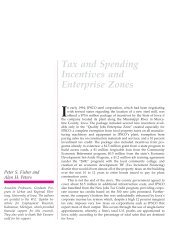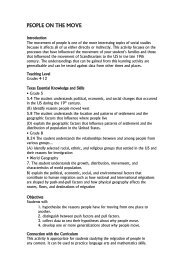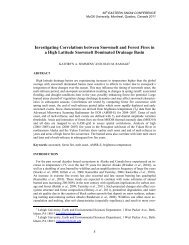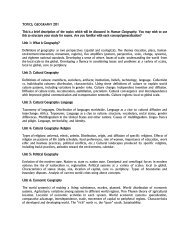Texas Social Studies Framework - Department of Geography ...
Texas Social Studies Framework - Department of Geography ...
Texas Social Studies Framework - Department of Geography ...
Create successful ePaper yourself
Turn your PDF publications into a flip-book with our unique Google optimized e-Paper software.
42<br />
42<br />
Figure 16 provides an example <strong>of</strong> a data retrieval chart<br />
that can help students organize information based on a<br />
generalization, e.g., “The physical environment (climate,<br />
landforms, and natural resources) in which Native<br />
Americans lived influenced how they lived (food,<br />
clothing, shelter, tools).” Students gather facts, elicit prior<br />
knowledge from memory, and place that knowledge into<br />
the data retrieval chart.<br />
2) Concept Mapping: Structuring material visually<br />
as a chain, a spider, overlapping circles, or a hierarchical<br />
or hybrid “map” is a very powerful strategy<br />
(see Figures 17 and 18).<br />
Students need explicit practice to develop meaningful<br />
and useful concept maps, but once they have a repertoire<br />
useful for different purposes, this is an excellent way for<br />
students to analyze complex ideas or text and to simplify<br />
it into memorable “mind pictures.” Figure 17 illustrates a<br />
flowchart that is useful in analyzing cause-and-effect<br />
relationships. Figure 18 features a Venn Diagram that<br />
enables students to compare and contrast information.<br />
Bridging Strategies<br />
A third type <strong>of</strong> cognitive strategy, bridging, helps<br />
students recall what they know and then transfer the<br />
knowledge to new topics. Advance organizers, metaphors,<br />
and analogies help students accomplish this (see<br />
Figure 19).<br />
Native<br />
Americans<br />
Caddo<br />
Coahuiltecan<br />
Comanche<br />
Karankawa<br />
Kiowa<br />
Waco<br />
Chapter 5: The Teaching-Learning System: Curriculum, Instruction, and Assessment<br />
General Purpose Strategies<br />
General purpose strategies are useful ways to study<br />
material and reinforce ideas. They include such strategies<br />
as rehearsal/repetition, the use <strong>of</strong> mnemonics, and study<br />
strategies (see Figure 20).<br />
Multiple Intelligences<br />
Some educators contend that different types <strong>of</strong> intelligence<br />
account for human abilities. These ideas reflect the<br />
influence <strong>of</strong> Howard Gardner and his theory <strong>of</strong> multiple<br />
intelligences, but L. L. Thurstone proposed “primary<br />
mental abilities” in 1938 and J. P. Guilford considered<br />
the nature <strong>of</strong> human intelligence, setting forth a model <strong>of</strong><br />
intelligence in the 1960s (Guskey, 1999).<br />
Gardner says the multiple intelligences include:<br />
• Logical mathematical intelligence: an<br />
individual’s ability to understand logical and<br />
numerical patterns and relations<br />
• Linguistic intelligence: the ability to acquire and<br />
use a large elaborate vocabulary<br />
• Musical intelligence: the ability to create and<br />
enjoy music<br />
• Spatial intelligence: the ability to recognize<br />
visual spatial relationships, think three-dimensionally,<br />
and use imagery<br />
Figure 16: Data Retrieval Chart<br />
Native Americans, Environment, and Lifestyle in <strong>Texas</strong><br />
TEKS 4.1.A and 7.2.A<br />
Physical Environment Lifestyle<br />
Climate Landforms Natural<br />
Resources<br />
Food Clothing Shelter Tools
















